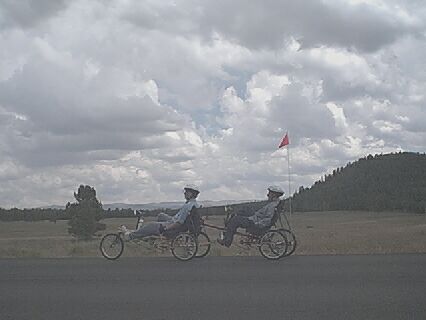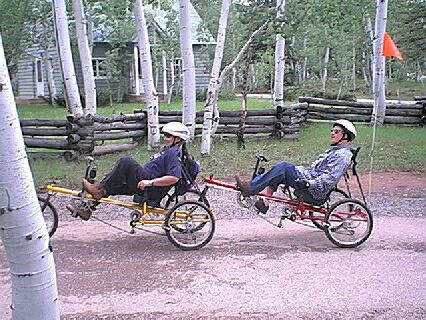
Last year, my parents bought a pair of Penninger
Voyager recumbent trikes. One reason they bought the trikes is that
my brother has visual and balance problems that have prevented him from
driving a normal bike or an automobile. The trikes have been a great
success for him--he got the hang of the trikes first by riding in the rear
trike, with the two trikes connected together, and now rides regularly,
both on his own and in tandem with another person.
I would highly recommend recumbent trikes for people with balance and
mobility problems, or who are afraid of the injuries that may occur if
they tip over on a regular bike. I always think that recumbent trikes could
and should find much more widespread use among older people and
people with certain disabilities. I often see older people riding the old-fashioned,
high-seated tricycles--but these have a very high center of balance and
are very tippy. These high-seated trikes are, in fact, rather dangerous.
A recumbent trike has a much lower center of gravity and won't tip
over if driven at slow to moderate speeds. It won't tip over at moderate
to high speeds, either, if the operator exercises a modicum of care and
skill. In general, riding recumbent trikes is safe (probably as safe
as or safer than walking!) and can provide a wonderful sense of mobility
and a fun way to build strength and endurance, for many who could not ride
bicycles or walk long distances.
The one downside to recumbent trikes is their price--they can be rather
expensive. But their price should be seen in context. The cost of
a trike is more than a simple bike, but less than cost of buying/maintaining/operating
a motor vehicle for a year. It is far less than the cost of
a coronary bypass operation! The trike can by be invaluable if it
provides mobility and strength training that are difficult to gain any
other way.
Many specialized items of use to disabled people are expensive simply
because they are specialized and do not sell in mass market quantities.
Recumbent tricycles are no exception.
Which recumbent trike should you buy? The answer depends on your budget,
abilities, and specific needs. We purchased the Penninger Trikes for these
reasons:
We have found the "tandem trike" to be surprisingly useful and
fun. The trike in front drives, the rider in back pedals and enjoys the
view. The two trikes pedal and shift independently, so each rider can go
at his/her own speed and cadence. One rider can even rest completely
while the other pedals.

The tandem trike, then, is a perfect setup for those with visual impairments
or other disabilities that prevent them from riding a trike (or bike) alone.
This is what we were thinking about when we bought the trikes with the
tandem attachment. But we have found that the tandemed trikes are a lot
of fun for everybody! When the trikes are tandemed, the riders stay together.
They can chat and enjoy the ride together. When two bike riders go together,
inevitably one wants to go faster than the other. So one person is
always hold back or the other always straining to catch up. Even when "together",
often the bikes are more than 5 or 10 feet apart--a distance far enough
to make conversation difficult.
With the trikes tandemed, all these problems are solved. The two riders
are close enough to enjoy each others' company. Regardless of differences
in strength and endurance, both riders stay together.
You will likely find that your average speed on a trike is a little
lower than it would be on a bike. On a perfectly flat course, I was able
to average 16 or 18 mph on one of the trikes--probably not much, if any,
slower than I would do on a bike. But trikes are quite a bit heavier than
bikes, and as soon as you start climbing, the extra weight catches up with
you. In a long, steep climb you may find yourself going 2-4 mph--maybe
half the speed you could do on a bike. But on a bike, 2-4 mph is uncomfortable--it
is a struggle to maintain balance and a reasonably straight line. On a
trike, that same slow speed is still pleasant, stable, and enjoyable. The
Penninger trikes have plenty of gearing to maintain a comfortable cadence
even at 2 mph. Want to stop and take a breather? Fine--you'll have
no problem getting started again, and you've brought a comfortable lounge
chair along with you . . .
In general, my observation is that the trikes are about as fast as bikes
on the level or slight downhill. On uphills, they're slower than
bikes and on downhills, they can be faster than bikes.
While visiting my parents this spring we went on several upright bike
and trike rides. We all agreed that riding the trikes is just more fun
than riding bikes! The seats are comfortable and there is no pain in the
behind, hands, arms, shoulders, back, or neck. And vehicles give the trikes
a far wider berth than they do bicycles.
So, yes they're a bit slower. But I'll take an hour and ten minutes
of fun on the trikes any day, over an hour on a bike to cover the same
distance. . .
You can find out more about Penninger Trikes on the Penninger web site
at http://www.penninger.com.
You can find the Triking FAQ at steve.at/pages/faq.html.
The FAQ includes a list of trike manufacturers with links to their web
sites. The FAQ also has good advice and tips for trikers and for
the use of trikes by disabled riders.













